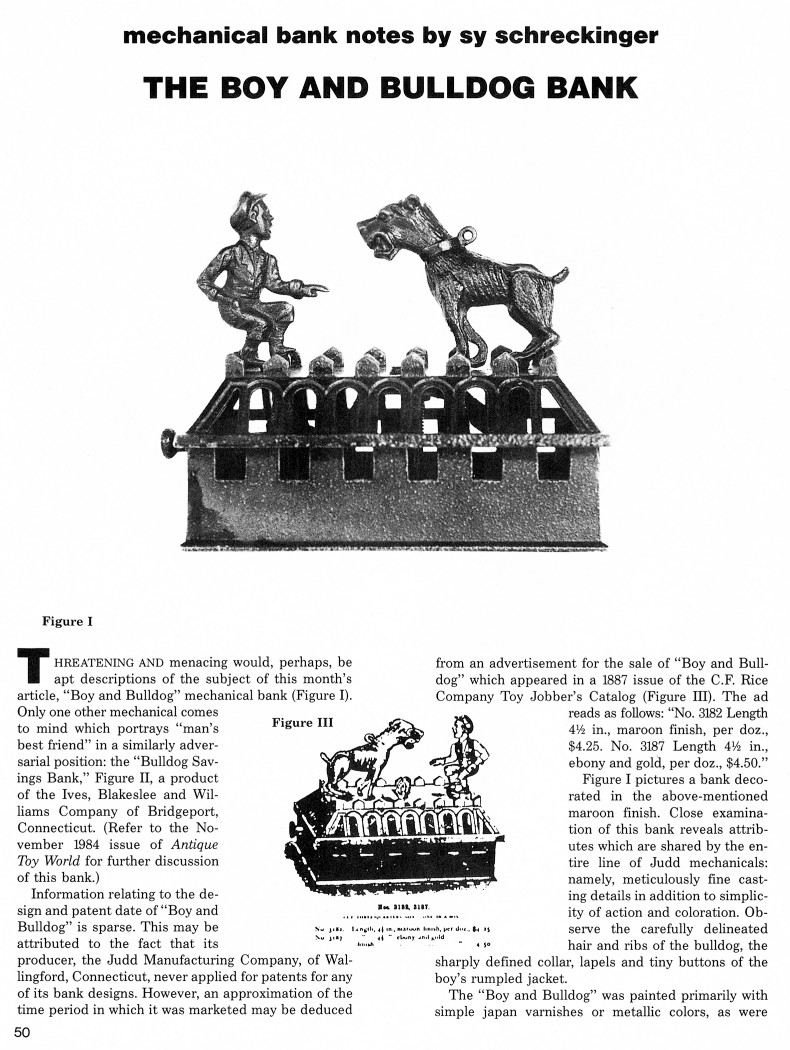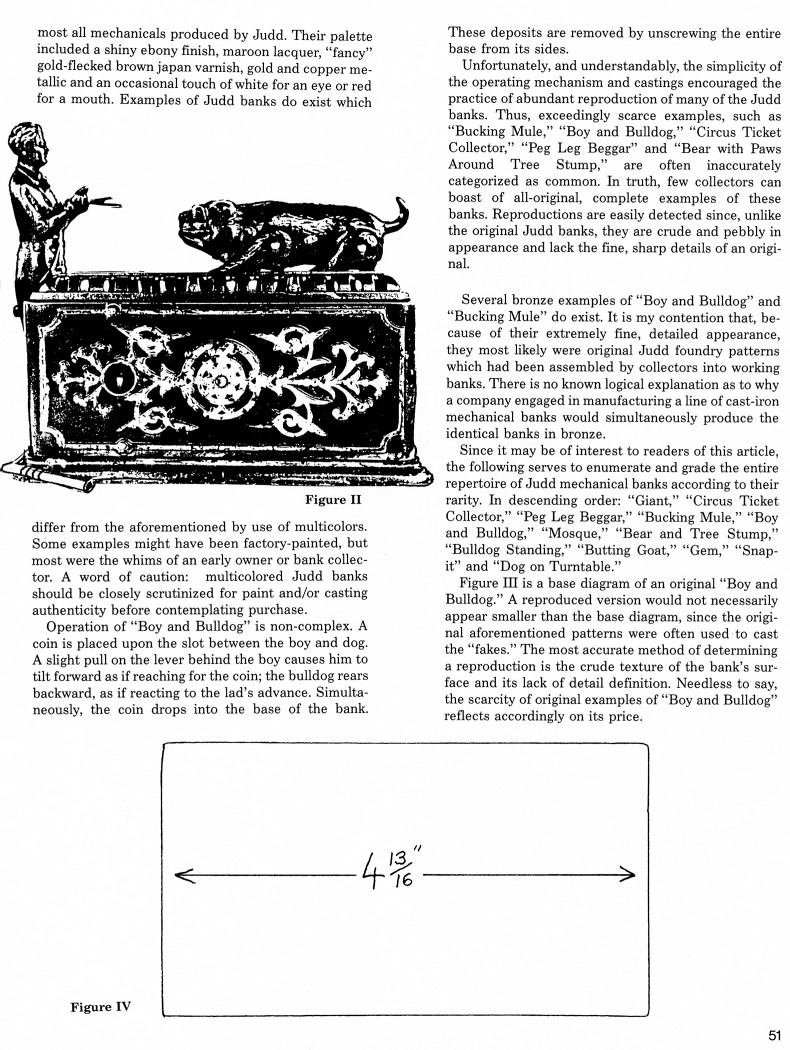|
The Boy and Bulldog Bank
by Sy Schreckinger – ANTIQUE TOY WORLD Magazine – July, 1989
Threatening and
menacing would, perhaps, be apt descriptions of the subject of this
month's article, "Boy and Bulldog" mechanical bank (Figure I). Only one
other mechanical comes to mind which portrays "man's best friend" in a
similarly adversarial position: the "Bulldog Savings Bank," Figure II, a
product of the Ives, Blakeslee and Williams Company of Bridgeport,
Connecticut. (Refer to the
November 1984 issue of Antique Toy World for
further discussion of this bank.)
Information relating to the design and patent date of "Boy and
Bulldog" is sparse. This may be attributed to the fact that its producer,
the Judd Manufacturing Company, of Wallingford, Connecticut, never
applied for patents for any of its bank designs. However, an approximation
of the time period in which it was marketed may be deduced from an
advertisement for the sale of "Boy and Bulldog" which appeared in a 1887
issue of the C.F. Rice Company Toy Jobber's Catalog (Figure III). The ad
reads as follows: "No. 3182 Length 4-1/2 in., maroon finish, per doz.,
$4.25. No. 3187 Length 4-1/2 in., ebony and gold, per doz., $4.50."
Figure I pictures a bank decorated in the above-mentioned maroon
finish. Close examination of this bank reveals attributes which are shared
by the entire line of Judd mechanicals: namely, meticulously fine casting
details in addition to simplicity of action and coloration. Observe the
carefully delineated hair and ribs of the bulldog, the sharply defined
collar, lapels and tiny buttons of the boy's rumpled jacket.
The "Boy and Bulldog" was painted primarily with simple japan
varnishes or metallic colors, as were most all mechanicals produced by
Judd. Their palette included a shiny ebony finish, maroon lacquer, "fancy"
gold-flecked brown japan varnish, gold and copper metallic and an
occasional touch of white for an eye or red for a mouth. Examples of Judd
banks do exist which differ from the aforementioned by use of multicolors.
Some examples might have been factory-painted, but most were the whims of
an early owner or bank collector. A word of caution: multicolored Judd
banks should be closely scrutinized for paint and/or casting authenticity
before contemplating purchase.
Operation of "Boy and Bulldog" is non-complex. A coin is placed upon
the slot between the boy and dog. A slight pull on the lever behind the
boy causes him to tilt forward as if reaching for the coin; the bulldog
rears backward, as if reacting to the lad's advance. Simultaneously, the
coin drops into the base of the bank. These deposits are removed by
unscrewing the entire base from its sides.
Unfortunately, and understandably, the simplicity of the operating
mechanism and castings encouraged the practice of abundant reproduction of
many of the Judd banks. Thus, exceedingly scarce examples, such as
"Bucking Mule," "Boy and Bulldog," "Circus Ticket Collector," "Peg Leg
Beggar" and "Bear with Paws Around Tree Stump," are often inaccurately
categorized as common. In truth, few collectors can boast of all-original,
complete examples of these banks. Reproductions are easily detected since,
unlike the original Judd banks, they are crude and pebbly in appearance
and lack the fine, sharp details of an original.
Several bronze examples of "Boy and Bulldog" and "Bucking Mule" do
exist. It is my contention that, because of their extremely fine, detailed
appearance, they most likely were original Judd foundry patterns which had
been assembled by collectors into working banks. There is no known logical
explanation as to why a company engaged in manufacturing a line of
cast-iron mechanical banks would simultaneously produce the identical
banks in bronze.
Since it may be of interest to readers of this article, the following
serves to enumerate and grade the entire repertoire of Judd mechanical
banks according to their rarity. In descending order: "Giant," "Circus
Ticket Collector," "Peg Leg Beggar," "Bucking Mule," "Boy and Bulldog,"
"Mosque," "Bear and Tree Stump," "Bulldog Standing," "Butting Goat,"
"Gem," "Snap-it" and "Dog on Turntable."
Figure III is a base diagram of an original "Boy and Bulldog." A
reproduced version would not necessarily appear smaller than the base
diagram, since the original aforementioned patterns were often used to
cast the "fakes." The most accurate method of determining a reproduction
is the crude texture of the bank's surface and its lack of detail
definition. Needless to say, the scarcity of original examples of "Boy and
Bulldog" reflects accordingly on its price.
|


